During the pandemic I was, like many folks, stuck at home with only a few quick trips out when necessary, and I spent lots of time on the computer, watching video after video. It eventually occurred to me that something good could come out of all the “alone time,” and I went back to one of my favorite pastimes of the last 50 years or so: researching the possibilities of owning a boat, something special that I could pass down, and would last generations. I stumbled on Giesler Boats, and there was something about the company that struck a chord with me.
In October 2022, after exchanging emails for several months with Gerry Giesler, the third-generation owner of B. Giesler and Sons Ltd. in Powassan, Ontario, my wife Theresa and I went up for a visit to his shop. Taking in the smell of the wood, varnish, and sawdust on the floor, I was hooked, and asked Gerry where I should send the deposit
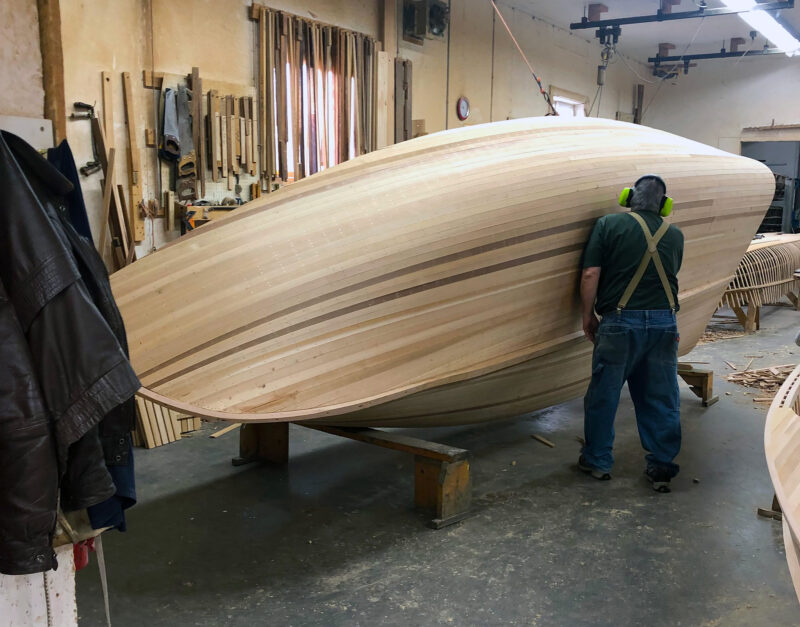 Al Lyall
Al LyallThe Giesler hulls are made of western red cedar shiplap strips, whch are then sanded using both electric palm sanders and hand sanders. Bottoms can be fiberglassed as an optional extra.
We ordered the Georgian Bay, an 18′ cedar-strip runabout, which would include a 60-hp Yamaha high-thrust four-stroke outboard with electric trim. The base model of the boat, without any of the options offered on the Giesler website, is perfectly fine and I would think it would do well with a 40-hp, but our lakes are large and deep and can be choppy, so the bigger, tougher motor was better suited to our needs.
Theresa and I wanted a real beauty, so we had Giesler Boats add a mahogany coaming to wrap around the top rails and around the front deck. I wanted a solid wood cockpit sole (or at least something other than the standard cedar and pine slats), but that didn’t happen as Gerry wasn’t enthusiastic about the change.
While we selected a long list of upgrades from the Giesler website, we didn’t think that the extra touches were particularly expensive considering the affordable base price of the boat. Gerry thought, based on how we intended to use the boat, that we should add a couple of inches to the freeboard, a longer front deck, and a rear deck with a splash well. There were also some cosmetic additions, which is where Giesler boats really shine as no two are alike.
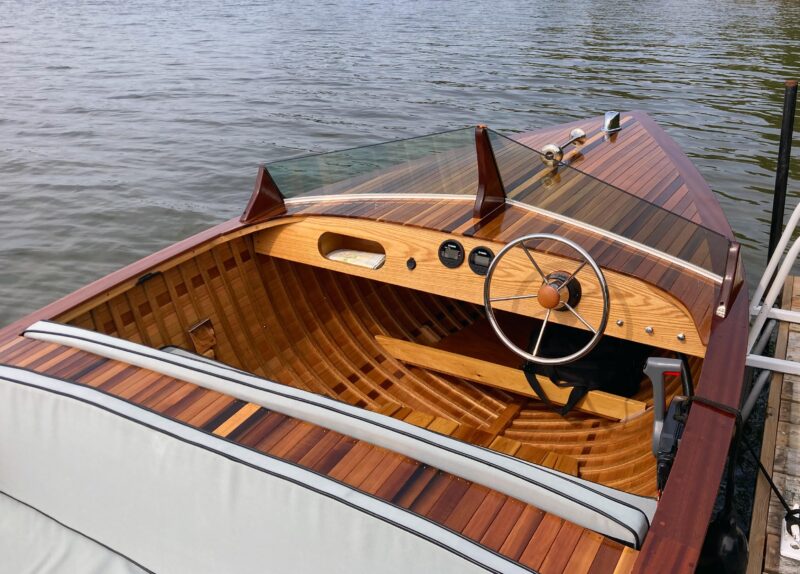 Al Lyall
Al LyallNo two boats are the same. Here the foredeck is longer and the freeboard was raised a couple of inches. The mahogany sidedeck that wraps around the cockpit and foredeck was requested by the author. The wood brackets for the custom windshield were made in-house, and the oak strip laid into the center of the decks complements the oak dashboard.
Most of the wood—cedar, maple, oak, pine, walnut, and mahogany—is sourced from North America, as locally as possible. The boats are hand-built using molds/frames that have been around for almost 100 years (with some repair along the way as constant use wears down the wooden molds) but the design and building technique have not changed much.
The hulls are made of western red cedar shiplap strips measuring 3⁄8″ × 1 5⁄8″ and clench-nailed to the frames. The strips are applied on steam-bent 11⁄16″ × 3⁄8″ oak frames and fastened with thousands of copper nails. The hull is then sanded smooth by hand or with a palm sander. Giesler Boats offers the option to have the bottom fiberglassed and painted with antifouling paint.
The transom is mahogany, the dash oak, and the seats are pine. Gerry added a decorative oak and walnut stripe down the center from foredeck to transom, a very nice touch. The wood brackets for the custom windshield are made in-house.
Gerry and his crew always had time for us: we went to see them every two weeks once the build started, and while we always had lots of questions, they never seemed to get tired of us. They started our boat on April 2, and we put it in the water on June 24.
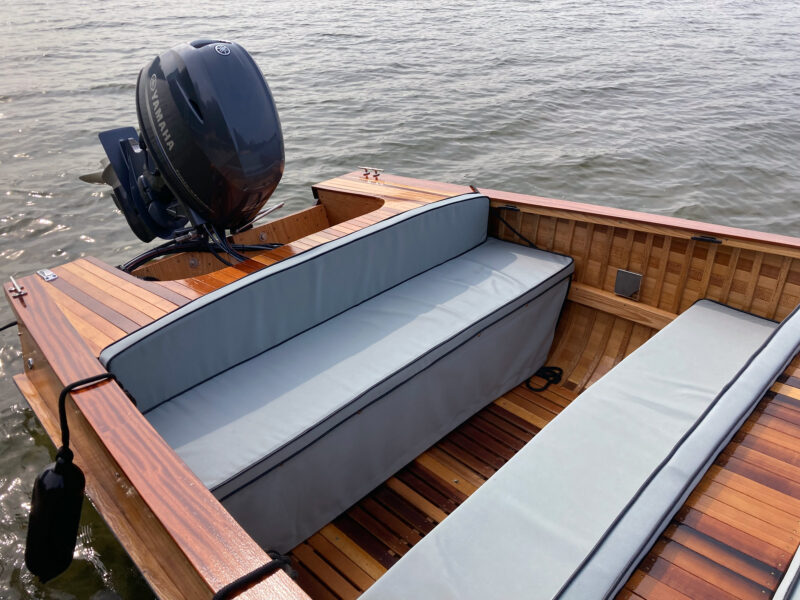 Al Lyall
Al LyallWith two bench seats aft of the bridge deck as well as the bench seat forward, there is comfortable seating for as many as six passengers. The cedar slat floorboards that mirror the strip-planked decks, are standard. The fuel tank is behind the aft bench.
Once the boat was complete, it went over to Giesler Marine, run by Gerry’s cousin Mark, for the mechanical end of things. They do an in-water boat test, give you a full tank of gas, help hook up the trailer to your vehicle, and have the boat ready to launch when you pick it up. Gerry even registers the boat in your name and has the identification numbers ready to go on the sides as well as the plates on the trailer.
The boat, motor, and trailer come in at just under 1,500 lbs, so I can tow it with my 2021 Rav4 which is rated at 1,500 lbs max for towing. We found it easy to tow the boat and put it into the lake at the ramp. We were lucky enough to get a slip at a local marina, so we don’t have to trailer from lake to lake.
My wife and I have both been around boats all our lives and have driven many but always with the owner present. It’s a whole different thing being on our own, but this little beauty makes it easy. It handles well, is not too powerful, and can take the rough water we get in our lakes. The wide beam and taller sides make it feel much larger than it is. At only 500 lbs you would think it would feel light and bounce around, but it has a solid, heavy feel and instills confidence.
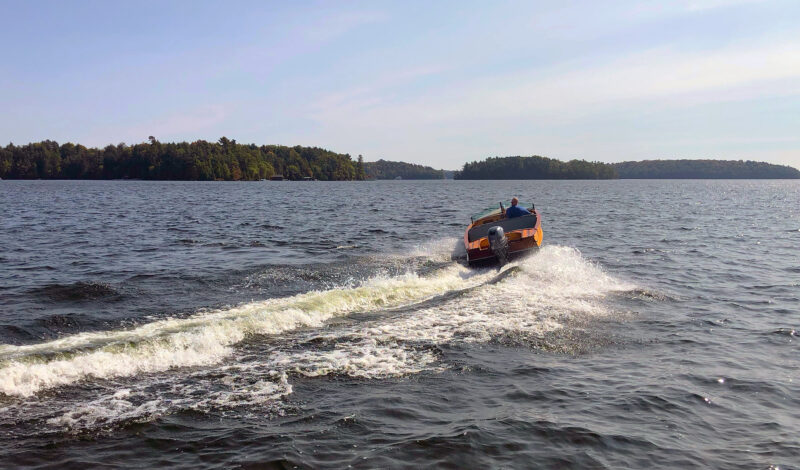 Theresa Lyall
Theresa LyallWith plenty of curve at the bilge, the boat banks into turns, a motion that will feel unfamiliar to drivers more used to the sliding motion of a hard-chined planing hull.
The boat has what Gerry calls “pretty much a displacement hull.” To me, it’s like a Maine lobsterboat with a big V in the front and flat on the back. It pushes through the water nicely at low speed, about 12 mph, and when you hit the throttle, it pops out of the water right away and comes up on plane around 19 to 21 mph.
It’s a nice soft ride as the boat pushes through the water, and very comfortable anywhere from 21 to 30 mph. It has a top speed of 33 mph with the 60-hp outboard at full throttle. I have played with the trim angle to bring the bow up a few degrees to get a bit more speed, but the boat will porpoise fairly easily from 23 mph on and I find that I have to trim back down. I was told by Gerry to just leave the trim all the way in to keep the bow down all the time, but I sometimes push it a bit on a calm day.
The hull, with its ample radius at the turn of the bilge, banks into turns made at speed. It’s a strange feeling at first, as it seems to slip out under you—very different from a planing hull with hard chines that slide through a turn. The Georgian Bay’s cornering is very forgiving and just plain fun.
 Theresa Lyall
Theresa LyallDespite weighing only 500 lbs the boat handles well and has a surprisingly heavy feel that inspires confidence in its seakeeping abilities.
The boat inspires confidence, as rough water does not seem to bother it. The sound of the water against the hull has surprised us at times as we remembered there was only ⅜” of cedar between us and the water. The whole experience soon becomes second nature, and the sound melts away. You can get a bit of spray if going through a big wake as it rides up the wake and comes down hard. I usually try to roll with a big wake or just avoid it all together.
The total draft is 22″: the boat draws 8″, and the motor trimmed all the way down adds 14″ so we can go between islands and look down through crystal-clear water to rock shelves close below. The shallow draft allows us to get into quiet bays, enjoy the landscape, and slip slowly between the islands dotting the Muskoka lakes.
I really could go on and on about this boat—it’s just that good. It is a solid, seemingly invincible small boat that’s mostly old school with just the right amount of modern safety and convenience. At the price you just can’t get any better. B. Giesler & Sons was started in 1927 and after almost 100 years of building boats, let’s hope they never stop.![]()
Al Lyall is a retired corrections officer living peacefully in Muskoka with his wife, Theresa (who still feels the need to work). He enjoys spending time with their adult children and grandchildren. A longtime dreamer of owning a classic boat, Al is now making up for lost time out on the lakes of Muskoka, Ontario.
Georgian Bay Particulars (standard hull)
Length: 18′
Beam: 75″
Depth: 30″
Weight: 500 lbs
Power: up to 90 hp
The Georgian Bay is available from B. Giesler & Sons for $9,200 (base price). Many options are available.
Is there a boat you’d like to know more about? Have you built one that you think other Small Boats readers would enjoy? Please email us!
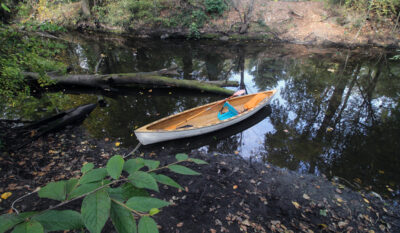



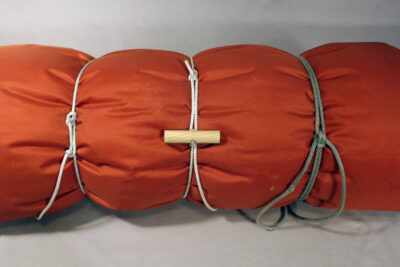
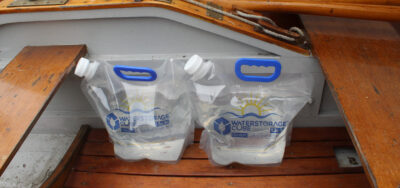
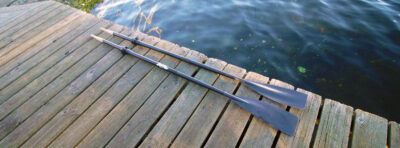
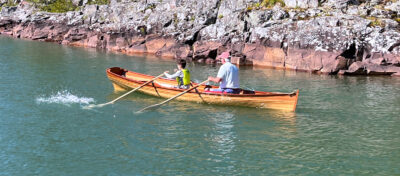

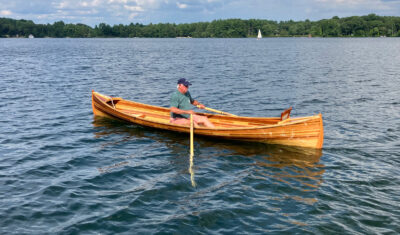
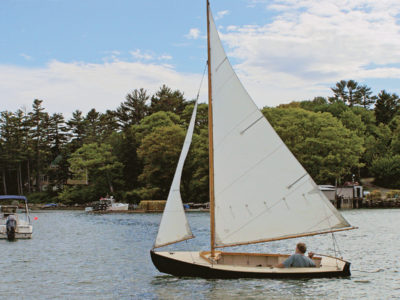
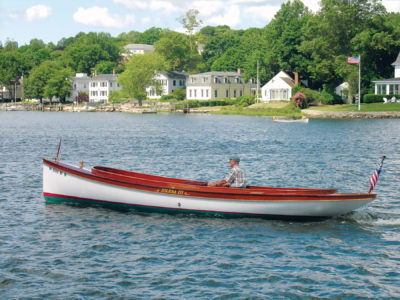
I am the owner of a 35-year-old Geisler Wherry, built well and to last, and at a price that is amazing. Great quality build and a pleasure to row two strokes and she is flying along.
Hi Roger,
I’m curious about that boat’s stability and safety in wave action. What have you found?
Thx,
Dave Mason
I am co-owner of a 2010 Giesler Georgian Bay and love the boat. Sure, it looks great, but it handles even better. I was concerned about maintaining all that bright wood but we leave it covered and the varnish has held up really well. An excellent choice!
Maintenance and durability are concerns for me as well. Fibreglass boats tend to drain to the transom where the bilge pump lives. This boat with its ribs catching water and it sitting there until it evaporates has me worried! Will the varnish stand up to that?
I remember as an early teen boy visiting the lakes in southern Ontario with my parents and seeing lovely wooden boats being employed by various outfitters. Could these have been Geisler boats? I know they were built in Powassen!
That was 65 years ago and I’d still like to have one!
We had a boat like just this for years by a company named Wolverine. Ours was built in the late 1940s and by 1973 we stripped the peeling varnish with water-based stripper, rinsed and dried the hull, and revarnished it all outdoors. You could used clear deck oil, then varnish a couple of coats over that. Store it indoors for a longer varnish life. Ours was under canvas most of the time or in our barn during the winter.
I have owned a Geisler Nippissing bought from the factory in 2007. The only maintenance I have needed to do is some touch up to the varnish. I keep the boat covered and make sure to wet vac it out before winter storage. I probably need an application of thinned varnish on the floor this year. The interior of the boat still looks pristine as I have been rigourous in keeping the boat covered.